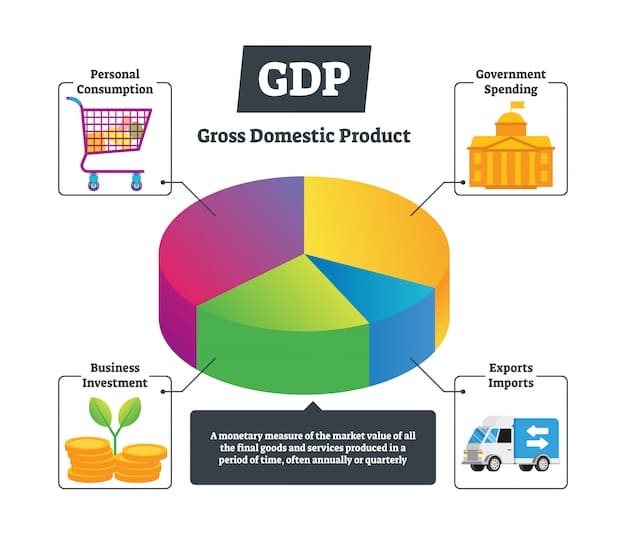Economic Indicators: Spotting Investment Opportunities in the Next Quarter

Economic Indicators: Key Data Points to Watch in the Next Quarter for Investment Opportunities provide critical insights into the US economy’s health, helping investors make informed decisions by identifying potential opportunities amid fluctuating market conditions.
Navigating the investment landscape requires a keen understanding of Economic Indicators: Key Data Points to Watch in the Next Quarter for Investment Opportunities. These indicators act as barometers of the economy, signaling potential shifts and opportunities for savvy investors. By tracking these data points, investors can gain a competitive edge and make more informed decisions.
Understanding Gross Domestic Product (GDP)
Gross Domestic Product (GDP) is the broadest measure of economic activity, representing the total value of goods and services produced in the US. Monitoring GDP trends provides a comprehensive view of the economy’s overall health.
GDP Growth Rate
The GDP growth rate indicates the percentage change in GDP from one period to another, typically quarterly or annually. A positive growth rate suggests economic expansion, while a negative rate signals contraction.
Investors watch the GDP growth rate to gauge the economy’s momentum. Strong GDP growth can lead to increased corporate profits and higher stock prices, making it an attractive environment for investment.
Components of GDP
Understanding the components that make up GDP—personal consumption, business investment, government spending, and net exports—is crucial for identifying growth drivers. Analyzing these components can reveal specific areas of strength or weakness in the economy.
- Personal Consumption: Consumer spending drives a significant portion of GDP, reflecting consumer confidence and purchasing power.
- Business Investment: Capital expenditures by businesses indicate their willingness to invest in future growth, suggesting optimism about economic prospects.
- Government Spending: Government investments in infrastructure, defense, and other areas can stimulate economic activity and create jobs.
- Net Exports: The difference between exports and imports reflects the US’s trade balance, influencing overall economic growth.
Monitoring GDP requires a deep-dive into its various components. A rise in consumer spending, for instance, may indicate increased consumer confidence, which can spur further economic activity. Declines in business investment could signal caution among businesses, suggesting a potential slowdown ahead.

In conclusion, understanding GDP, including its growth rate and components, is essential for assessing the overall health of the economy and making informed investment decisions. Investors should closely monitor GDP trends to identify potential opportunities and risks in the market.
Inflation Indicators: CPI and PPI
Inflation indicators, such as the Consumer Price Index (CPI) and the Producer Price Index (PPI), measure the rate at which prices are rising. These indicators are crucial for understanding the purchasing power of money and the overall stability of the economy.
Consumer Price Index (CPI)
The CPI measures the average change over time in the prices paid by urban consumers for a basket of goods and services. It reflects the cost of living and is a key indicator of consumer inflation.
Investors track CPI to understand how inflation is affecting consumer spending and corporate profits. High inflation can erode purchasing power and lead to decreased consumer spending, potentially impacting corporate earnings.
Producer Price Index (PPI)
The PPI measures the average change over time in the selling prices received by domestic producers for their output. It provides insights into inflation pressures at the wholesale level, often preceding changes in consumer prices.
Changes in PPI can signal future trends in CPI. Rising producer prices can indicate that businesses are facing higher input costs, which may eventually be passed on to consumers in the form of higher prices.
- Core Inflation: Excluding volatile food and energy prices, core inflation provides a clearer view of underlying inflation trends.
- Inflation Expectations: Surveys and market-based measures of inflation expectations can influence actual inflation trends and monetary policy decisions.
- Impact on Interest Rates: Central banks often adjust interest rates in response to inflation, influencing borrowing costs and economic activity.
Monitoring inflation indicators requires looking beyond the headline numbers. While CPI reflects the prices consumers pay, PPI offers a glimpse into the cost pressures faced by producers. Both CPI and PPI require careful consideration to ascertain their significance. By understanding both of these indicators, investors can better anticipate changes in consumer behavior, corporate profitability, and monetary policy.
In summary, CPI and PPI are essential inflation indicators that provide insights into consumer and producer price trends. Investors should monitor these indicators closely to assess the impact of inflation on their investments and the broader economy.
Employment Data: Unemployment Rate and Job Growth
Employment data, including the unemployment rate and job growth figures, provides insights into the labor market’s health and its impact on economic activity. Strong employment numbers typically indicate a healthy economy, while weak figures may signal a slowdown.
Unemployment Rate
The unemployment rate measures the percentage of the labor force that is unemployed but actively seeking employment. It’s a key indicator of labor market slack and economic health.
A low unemployment rate suggests a tight labor market, where employers may face challenges finding workers. This can lead to wage pressures and potentially higher inflation.
Job Growth
Job growth measures the net change in the number of employed individuals. It reflects the economy’s ability to create new jobs and absorb unemployed workers.
Strong job growth can boost consumer confidence and spending, contributing to overall economic growth. Conversely, weak job growth may signal a weakening economy.

- Labor Force Participation Rate: Measures the percentage of the population that is either employed or actively seeking employment.
- Underemployment Rate: Includes individuals who are employed part-time for economic reasons or who are marginally attached to the labor force.
- Initial Jobless Claims: Weekly data on the number of new claims for unemployment benefits, providing a timely indicator of layoffs.
Monitoring employment data requires more than just the unemployment rate. The labor force participation rate offers insights into how many people are actively engaged in the job market, while the underemployment rate captures those who are not working at their full potential. By assessing these various metrics, a more complete understanding of how the labor market is behaving begins to take shape.
In conclusion, the unemployment rate and job growth are critical employment indicators that reflect the health of the labor market. Investors should monitor these figures closely to assess the impact on economic activity and investment opportunities.
Interest Rates and the Federal Reserve
Interest rates, particularly those set by the Federal Reserve (the Fed), play a crucial role in influencing economic activity. Changes in interest rates can affect borrowing costs, investment decisions, and overall economic growth.
Federal Funds Rate
The federal funds rate is the target rate that the Fed wants banks to charge one another for the overnight lending of reserves. It serves as a benchmark for other interest rates throughout the economy.
The Fed uses the federal funds rate to influence inflation and economic growth. Lowering the rate can stimulate economic activity by reducing borrowing costs, while raising the rate can help curb inflation.
Impact on Borrowing Costs
Changes in the federal funds rate can impact borrowing costs for consumers and businesses. Lower interest rates can make it cheaper to finance purchases and investments, while higher rates can increase the cost of borrowing.
Investors should monitor the Fed’s interest rate decisions to anticipate changes in borrowing costs and their potential impact on economic activity. Lower rates can boost consumer spending and business investment, while higher rates can dampen economic growth. This awareness can guide strategic financial decisions.
The Fed also uses other tools to influence monetary policy, such as quantitative easing (QE) and forward guidance. QE involves the purchase of government bonds and other assets to inject liquidity into the financial system, while forward guidance communicates the Fed’s intentions regarding future policy decisions.
- Inflation Targets: The Fed aims to maintain stable prices, typically targeting an inflation rate of around 2%.
- Economic Projections: The Fed releases economic projections, including forecasts for GDP growth, unemployment, and inflation.
- Minutes of Meetings: The minutes of the Fed’s meetings provide insights into the discussions and considerations that informed their policy decisions.
In conclusion, understanding interest rates and the Federal Reserve’s policies is essential for navigating the investment landscape. Investors should monitor the Fed’s decisions and communications to anticipate changes in borrowing costs and their impact on economic growth and investment opportunities.
Housing Market Indicators
Housing market indicators provide insights into the health of the real estate sector and its impact on the broader economy. The housing market is a significant driver of economic activity, influencing consumer spending, construction, and employment.
New Home Sales
New home sales measure the number of newly constructed homes sold during a given period. It’s an indicator of demand for housing and the overall health of the construction industry.
Rising new home sales suggest strong demand for housing and can stimulate economic activity through increased construction and related industries. Conversely, declining sales may signal a weakening housing market.
Existing Home Sales
Existing home sales measure the number of previously owned homes sold during a given period. It provides insights into the overall health of the housing market and consumer confidence.
Strong existing home sales indicate a healthy housing market and can boost consumer spending on home-related goods and services. Declining sales may signal caution among buyers and a potential slowdown in the housing market.
Other housing market indicators include housing prices, mortgage rates, and housing inventory. Rising housing prices can boost homeowner wealth and consumer confidence, while higher mortgage rates can dampen demand for housing.
- Housing Starts: Measures the number of new residential construction projects begun during a given period.
- Building Permits: Indicates the number of approvals granted for new construction projects.
- Mortgage Delinquency Rates: Measures the percentage of homeowners who are behind on their mortgage payments.
Considering the behavior in the housing market requires investors to monitor housing starts, building permits, and mortgage delinquency rates. Housing starts and building permits shed light how much activity is on the horizon in the construction industry, while mortgage delinquency rates can provide insight into the degree to which people are struggling to be able to afford their homes. When combined, these various pieces of information provide a clearer perspective on the housing market. By assessing these various metrics, strategic decisions can be made.
In summary, new home sales and existing home sales are critical housing market indicators that reflect the health of the real estate sector. Investors should monitor these figures closely to assess the impact on economic activity and investment opportunities.
Consumer Confidence and Retail Sales
Consumer confidence and retail sales provide insights into consumer sentiment and spending patterns, which are major drivers of economic activity. Consumer spending accounts for a significant portion of GDP, making these indicators essential for understanding the economy’s health.
Consumer Confidence Index
The Consumer Confidence Index (CCI) measures consumers’ feelings about current and future economic conditions. It reflects their willingness to spend and invest.
A high CCI suggests that consumers are optimistic about the economy and are more likely to spend, boosting retail sales and overall economic growth. A low CCI may signal caution among consumers and a potential slowdown in spending.
Retail Sales
Retail sales measure the total value of sales at retail stores. It provides insights into consumer spending patterns and demand for goods and services.
Strong retail sales indicate healthy consumer spending and can contribute to economic growth. Weak retail sales may signal a slowdown in consumer spending and a potential drag on the economy.
Other factors, such as income levels, employment trends, and interest rates, can also influence consumer confidence and retail sales. Rising income levels and job growth can boost consumer sentiment and spending, while higher interest rates can dampen demand for credit-sensitive goods and services.
- Durable Goods Orders: Measures new orders placed with manufacturers for durable goods, which are products expected to last three years or more.
- Personal Income and Outlays: Provides data on personal income, spending, and savings.
- Savings Rate: Measures the percentage of disposable income that consumers are saving.
Consumer confidence and retail sales are intertwined, with one influencing the other. For example, if consumers are optimistic about the economy, they are more likely to make purchases, leading to increased retail sales. Conversely, if they are concerned about economic conditions, they may reduce their spending, resulting in lower retail sales. Therefore, monitoring both indicators can provide valuable insights into the overall health of the economy and potential investment opportunities. By understanding these indicators, wise and calculated judgements can be made.
In conclusion, consumer confidence and retail sales are essential indicators of consumer sentiment and spending patterns. Investors should monitor these figures closely to assess the impact on economic activity and investment opportunities.
| Key Indicator | Brief Description |
|---|---|
| 📈 GDP Growth | Measures the rate the economy is expanding or contracting. |
| 💲 Inflation (CPI/PPI) | Reflects the rate at which consumer and producer prices are changing. |
| 💼 Unemployment Rate | Indicates the percentage of the labor force seeking employment. |
| 🏡 Housing Market | Provides insight into real estate sector, affecting construction and spending. |
Frequently Asked Questions (FAQ)
▼
Key indicators include GDP growth, inflation rates (CPI/PPI), unemployment rate, housing market data, consumer confidence, and retail sales. These provide a comprehensive view of economic health.
▼
A strong GDP growth rate often leads to increased corporate profits and higher stock prices, making it an attractive environment for investment. Conversely, a negative rate may indicate caution.
▼
CPI and PPI reflect consumer and producer price trends, respectively. Monitoring these helps assess inflation’s impact on consumer spending, corporate profits, and Federal Reserve policies.
▼
The unemployment rate indicates labor market slack and overall economic health. A low rate suggests a tight labor market, potentially leading to higher wages and inflation.
▼
Housing market indicators like new and existing home sales influence consumer spending, construction, and employment. Strong sales boost economic activity, while declining sales may signal a slowdown.
Conclusion
Keeping a close eye on the Economic Indicators: Key Data Points to Watch in the Next Quarter for Investment Opportunities is crucial for making well-informed investment moves. By diligently tracking these data points, scrutinizing economic trends, and understanding the relationship with the marketplace, both seasoned and fresh investors can improve their abilities to adapt quickly and spot opportunities, building a foundation for success and resilience in managing their own financial matters.